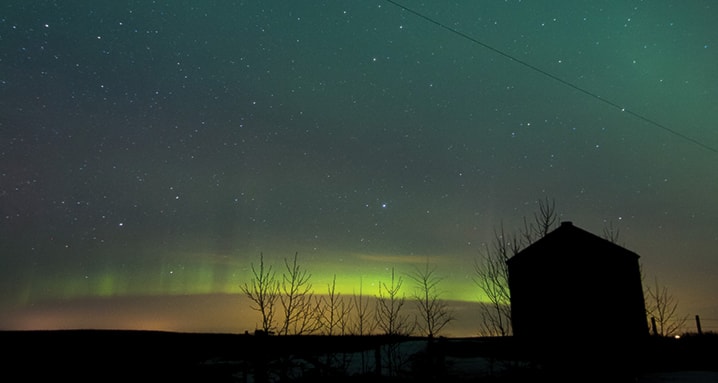She’s been chasing the northern lights for a few years now, but this week’s spectacular cinematic view was unlike any other she has seen.
Keely Gibb, a line locator by day but a photography enthusiast by night, shot some awe-inspiring photos north of Eckville late Tuesday and into early Wednesday morning.
So did hundreds of other people who stayed up long enough to witness and post photos online. The photos are the results of a massive geomagnetic storm in North America that resulted in a better-than-usual aurora borealis performance.
The University of Alberta’s online AuroraWatch project dubbed it the St. Patrick’s Day Aurora, aptly so since there was a lot of mesmerizing green in it.
The site issues alerts whenever there’s a good chance of seeing aurora, the northern lights. People can sign up via email to get the alerts. On Thursday, for example, the chance was only 21 per cent. But on Wednesday it was a “red alert” at about a 95 per cent chance, albeit that was at 3 a.m.
Magnetic storms (geomagnetic activity) are measured on a scale from G1 to G5. This week’s storm was a G4.
The National Oceanic and Atmospheric Administration in the U.S. said the G4 solar storm was the result of two coronal mass ejections (CMEs), observed leaving the sun on March 15. CMEs are giant bubbles of gas and magnetic field, ejected from the sun.
The result — as particles around the Earth are disturbed — is a big light show in the sky.
The Canadian Space Agency explains the northern lights.
“Auroras occur when charged particles (electrons and protons) collide with gases in the Earth’s upper atmosphere, producing tiny flashes that fill the sky with colourful light. As billions of these tiny flashes occur in sequence, the lights appear to move or dance.
“In the northern hemisphere, the lights are named aurora borealis, or northern lights, while in the southern hemisphere they are called aurora australis, or southern lights.”
Earlier this week, Gibb, who is from Calgary, was visiting her parents, who live in the Rocky Mountain House rural area.
“I was actually inside and looking out the window and I could see them so that’s when I knew it was a good time to go out.”
She woke her parents up to see them — her father is from England and had never seen the northern lights — and then she drove off, chasing the lights to the Eckville area.
“When I saw them the other night, like how bright they were, I was just astonished. I’ve never seen them that bright before.
“They were pretty much dancing over top of me,” said Gibb, 24. She took a series of photos from 11 a.m. to 2 a.m. with her Canon 6DB, on a tripod, with 15-to-30-second time lapses.
“Half the time I get emails (alerts) at 2 a.m. and I’m sleeping. If I’m not working the next day, I’ll just go out driving and see if I can see anything,” she said.
“It’s kind of tricky. It’s not a guaranteed thing so you kind of have to go out and chase them and see where they are. You drive all over the place,” she said.
“The lights have been really good this year.”
Online:
—If you missed the show, you can watch aurora borealis live in Yellowknife, N.W.T., online via the Canadian Space Agency at www.asc-csa.gc.ca/eng/astronomy/auroramax
— The University of Alberta’s project is located online at www.aurorawatch.ca
—To get more information about the weather in space (if you’re tired of weather on Earth) and to find out when magnetic storms are happening, go to the U.S. Space Weather Prediction Centre at swpc.noaa.gov
barr@www.reddeeradvocate.com
